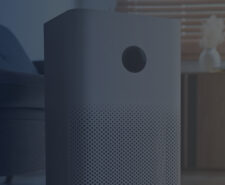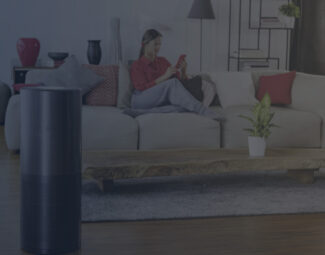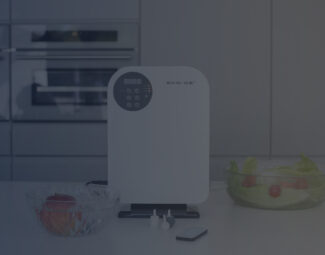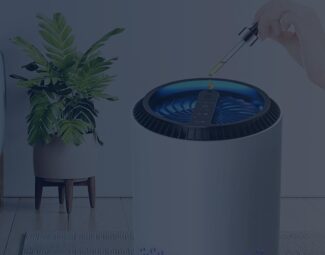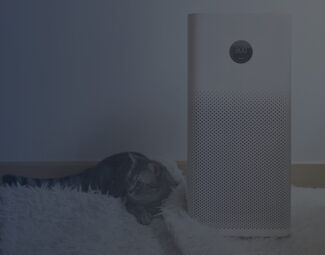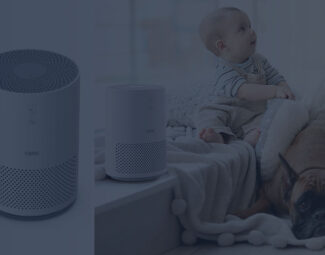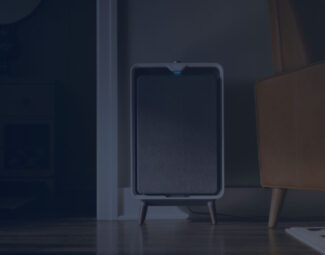W hile at times similar in their design and appearance, air purifiers, humidifiers, and dehumidifiers are completely different systems that serve different purposes, but their end goal is basically the same – creating better living conditions. With indoor air pollution reaching levels higher than ever these days and humidity levels seemingly out of balance regardless of the area folks live in, the addition of aiding systems is imperious to upkeep proper health. However, each of the aforementioned systems is of use only under specific circumstances, and in the following, we will inform you about their operation and applications so that you can accurately decide what you actually need to improve environmental conditions in your home.
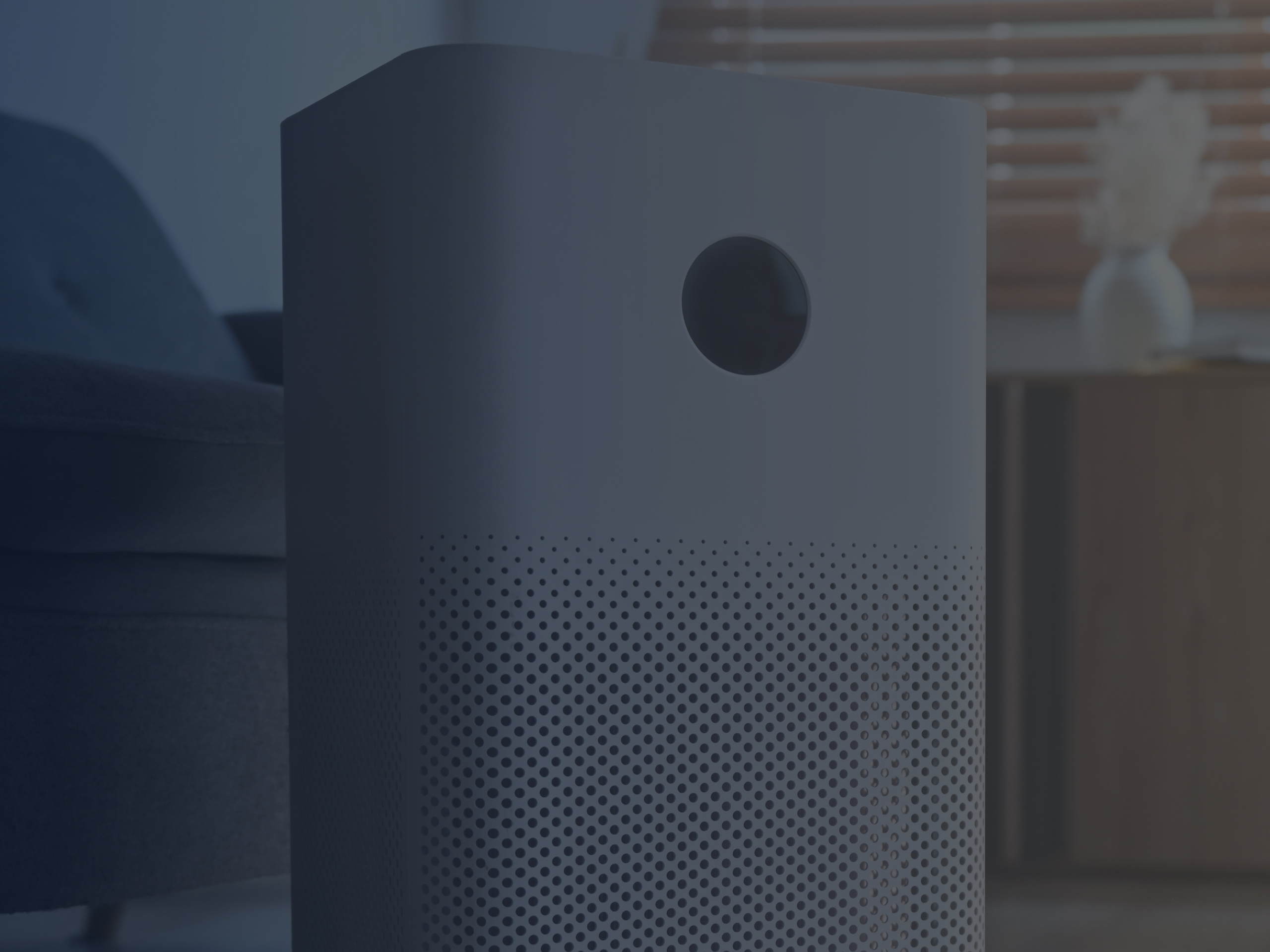
Indoor Air Purifier in Living Room
All You Need to Know About Air Purifiers
Definition: Air quality improvement device that serves the purpose of reducing polluting particles plaguing the air indoors.
How do air purifiers work?
Commonly, the systems consist of a fan that sucks the air in and circulates it, alongside one or multiple filters through which it is passed, the purpose of the filtering media being to catch polluting particles so that the air that comes out is pure. There are other technologies these systems can rely on, including UV light that provides air sanitization as it more effectively tackles microorganisms and pathogens, as well as ionizers that release negative ions to attract particles like static and remove them.
Tip: For unmatched efficiency in air pollutant reduction, look into a system that uses HEPA filtration as, by design, these filters are superior, capturing upward to 99.97% of particulates as small as 0.3 micrometers.
What are air purifiers good for?
While the general purpose is that of solving indoor air pollution issues, the exact use depends on the system type. According to the pollutants they are designed to reduce, they can be categorized as follows:
- Air purifiers for smoke removal: Systems specialized in the removal of cigarette smoke.
- Air purifiers for odor reduction: Systems specialized in the removal of household odors, regardless of their source, whether we are talking about smells left by cooking, cleaning products, pets, and tobacco.
- Air purifiers for dust removal: Systems specialized in the removal of dust particles and dust mites.
- Air purifiers for allergies and asthma: Systems specialized in the removal of all allergy and asthma-triggering particles, including mold spores, pollen, microorganisms, VOCs, and more.
- Air purifiers for pets: Systems specialized in the removal of pet dander and hair.
Check out the best air purifier and humidifier combo systems if you want to spare money and get a 2-in-1 product that removes pollutants from the air while simultaneously increasing humidity, this way saving money that you would have otherwise spent on two different devices.
Quick buying guide – What you should look into when you buy an air purifier
- Sizing compatibility: For proper efficacy, check for it to provide optimal performance in the room/space size you intend to use it in. Otherwise, it will underperform.
- CADR rating: This certified measurement shows the speed at which it removes smoke, pollen, and dust particulates. A higher rating indicates a more qualitative performance of the system when it comes to reducing that specific pollution issue.
- HEPA filter: By far the most effective media at trapping particulates of all sizes, including microscopic-sized elements, the HEPA media indicates pollution reduction by up to at least 99.97%.
Benefits
- Depending on the specific type and the filtration media or technologies used, the systems can actually remove almost all air-polluting particulates, creating a safer habitat indoors and ensuring you will breathe fresh, clean air at all times.
- Really handy for individuals who suffer from respiratory conditions as air contaminants can aggravate or trigger their symptoms.
- If the system can remove dust from the air, surfaces in your home won’t be as prone to getting as dusty either, which makes keeping the house clean easier.
- Cleaner air also helps in acne reduction and the improvement of skin appearance as pollutants won’t settle on it anymore.
- It slows down the skin aging process as it removes free radicals that flow into the air.
Drawbacks
- Some systems emit ozone and other by-products. When inhaled in large amounts or over prolonged periods by sensitive and healthy individuals alike, they can cause health complications.
- Cleaning an air purifier isn’t the hardest task out there, but it does take out of your time, and it can even require you to spend money if filter replacement is needed.

Man Turns On Humidifier
All You Need to Know About Humidifiers
Definition: Air quality improvement device that adds moisture into the air to increase humidity levels and upkeep RH within healthy parameters.
How do humidifiers work?
Air has relative humidity, and to maintain ideal living conditions, that level should be within 40% to 50% for proper comfort and health. According to the operating manner, the most sought-after humidifier types are evaporative systems that work by holding water into a basin, absorbing it through the wicking filter, and then using a fan to release moistness into the air. In some cases, the humidification system can be hooked up to the heating and cooling system of the house. Other types of humidifiers include:
- Steam/vaporizer: Boils water and releases the warm steam back into the room.
- Impeller: Water is flung by a rotating disc into a comb-like diffuser that serves the purpose of breaking it into fine droplets that are released into the room.
- Ultrasonic: A metal diaphragm produces vibrations at ultrasonic frequencies to create water droplets.
What are humidifiers good for?
The moisture released into the air acts as a natural moisturizing agent that relieves dryness and prevents its side effects. When you or any household member are dealing with dry skin, sinus congestion, dry throat, dry cough, cracked lips, nose irritation, or irritated vocal cords, it means that air dryness is taking a toll on your health. For their moisture-enhancing ability, humidifiers are ever-present in nurseries as babies are much more susceptible to sinus congestion, the extra moisture helping relieve their symptoms.
Tip: To make sure humidity levels need to be raised (stats are below 30%-40%), use an indoor hygrometer to check RH. You should also leave it on after you install a humidifier to check up on moistness levels and make sure the device doesn’t raise humidity levels more than recommended.
Quick buying guide – What you should look into when you buy a humidifier
- Area coverage: How big of a space you can use it in for the system to provide moisture increase at an optimal level. Using it in a wider space than recommended results in underperformance.
- Tank size: Amount of water the basin can hold, being preferable for it to be as large as possible so that you won’t have to refill it too often.
- Mist type and adjustment: Whether it releases cool mist, warm mist, or lets you pick between both types. Cool mist is better suited for the warm season as it can aid make the environment feel cooler and more pleasant, whereas warm mist comes in handy during wintertime when a little extra warmth doesn’t hurt. The adjustment refers to permitting you to determine exactly how much moisture it disperses with each passing hour.
- Humidistat/hygrometer: Displaying of the RH level in real-time is provided by the hygrometer, while the humidistat enables it to automatically turn on and off as needed to upkeep the pre-set moistness level.
Benefits
- Considerably reduced chances of cold and flu germs to linger in the air, so you won’t be at as big of a risk of getting sick when winter comes.
- What you might not know is that humid air, by default, makes your body feel warmer. Thus, as long as you run the system throughout winter, not only will you properly manage indoor moistness for health purposes, but you won’t feel the need to turn the heating system up as much, saving money in the process.
- Wallpaper, paint, wood floors, and furnishings, can all be affected by dry air, something that this system helps prevent and combat.
- Plants thrive better when humidity is at a proper level as well, especially seeing how most houseplants are tropical and thus, accustomed to higher temperatures and moistness.
Drawbacks
- If you don’t clean the humidifier properly, it can harbor bacteria and fungus, which will be released into the air during the misting procedure, exposing you to respiratory illness.
- If it is not self-regulated, meaning that it doesn’t feature a humidistat to limit it and ensure it won’t run for longer than needed, you could end up raising humidity levels more than needed. This can cause mold growth in the room, as well as other issues that emerge when humidity levels are too high.
- Some humidifiers can actually leave white dust on surfaces. This happens only if you use unfiltered tap water as the minerals in it fall when the mist is released into the air. To prevent this, use distilled water.
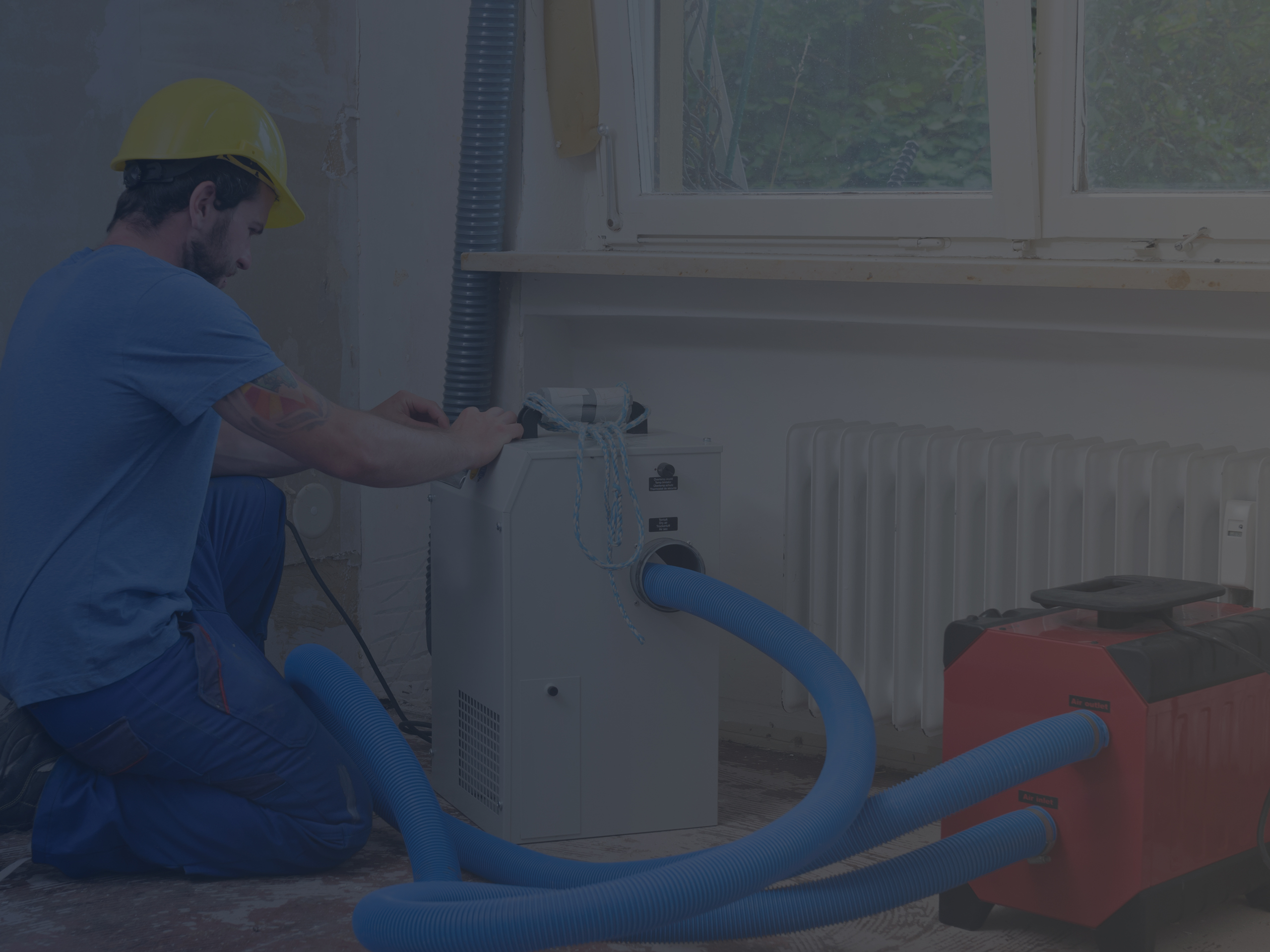
Professional Setting Up Dehumidifier
All You Need to Know About Dehumidifiers
Definition: Air quality improvement device that reduces excess moisture to decrease humidity levels and upkeep RH within healthy parameters.
How do dehumidifiers work?
There are two main types of dehumidifiers based on their functioning, more precisely refrigeration systems and absorption systems.
- Refrigeration system: The humid air in the room is pulled in through a side grille, an electric fan being utilized for this part of the process. Next, the air is passed over freezing pipes that cool it, the moisture being turned back into water that drips off the pipes into the collection bucket. Free of moistness, the air passes through the compressor and is warmed to its initial temperature before being released back into the room through the secondary grille, maintaining temperature comfort due to this small detail as well.
- Absorption system: A duct is utilized to pull in the moist air and as it enters the system, it is moved past a rotating wheel that is made of a material with the property of absorbing humidity. The air is pulled in by an electric motor fan and then released at the same temperature, only without the excess moisture.
What are dehumidifiers good for?
Excess dampness into any space spells bad news as excess moistness provides ideal growing ground for mold and mildew. Moreover, excess humidity can actually compromise the structural stability of a building, so it’s easy to see why it must be kept in check. Evidently, wood furniture has to suffer when the RH passes 50%, with damage ensuing even in this case. Generally, dehumidifiers are used in spaces and rooms that tend to get overly damp most often, which include:
- The bathroom: As you shower and bathe in it, condensation and excess moisture are bound to plague this specific room, and without the use of a moisture reduction system and proper ventilation, mold will appear.
- The crawl space: Encapsulation doesn’t suffice to prevent moistness in the crawl space as, without a dehumidifier, you could still end up compromising the structural integrity of the building via excess moisture that isn’t properly tended to.
- The basement: Another area of the house situated at below-ground level, because of improper air circulation and ventilation, the basement tends to get moist and mold is generally a common occurrence in it.
Quick buying guide – What you should look into when you buy a dehumidifier
- Covered area: Check for the maximum square footage the system can provide optimal dehumidification in to match the size of the area you intend to primarily use it in so that it won’t underperform.
- Continuous draining: If you don’t seek a system that allows you to connect it to a drain for continuous moisture dumping in it, you will find yourself having to routinely empty the collection bucket. Depending on excess moisture conditions and how long you run it, you could do this task once or even twice per day, which is bothersome.
- Defrost features: If you use it in the crawl space or basement, spaces that generally tend to be cold, defrost functions help prevent cold temperatures from damaging the coils and other internal parts of the system.
Benefits
- The most obvious upside is that it reduces moisture levels, and as most models feature humidistats, you can actually select the level at which the machine maintains RH indoors to create the most comfortable conditions for you.
- As humidity won’t rise above the recommended level, mold growth won’t occur either, which means that your home won’t suffer any structural damage, neither will you feel the negative health effects of inhaling mold spores (in asthma and allergy sufferers, this issue is one of great concern as mold triggers symptoms).
- All electronics in your home that feature exposed metal parts will see a prolonging of their lifespan as they won’t be in danger of rusting or corroding anymore.
- Protects wood furniture from rot, an inevitable outcome of high moisture levels in the air.
Drawbacks
- If it doesn’t provide continuous draining of the water or you don’t set it up for this, you will find yourself emptying the water basin quite often. If the basin doesn’t hold much water either, the chore becomes all the more annoying.
- Unless you acquire an Energy Star rated system, chances are that you won’t be happy with how much it will cost to run it.
- Most systems tend to blow warm air out of the back, so direct their back toward a door so that indoor temperatures won’t get unbearable because of the machine.
Air Purifiers vs. Humidifier vs. Dehumidifier - Systems Compared
Conclusion
Each system provides a specific functioning, each being designed for different needs, all related to the improvement of living conditions. An air purification system is essential no matter what as indoor air pollutants are a pressing issue and the system is the sole solution to fix it. However, when it comes to humidifiers and dehumidifiers, you might either need one or the other, or both but for different areas of the building. As they increase moisture levels, humidifiers are to be used in areas where RH levels tend to drop below 40%, whereas dehumidifiers, which are specialized in wicking away excess moistness, should be used where RH levels exceed 50%-55% and there is the danger of mold forming. Each with its own benefits, you should use them in your home depending on your specific needs to ensure a healthy habitat.

